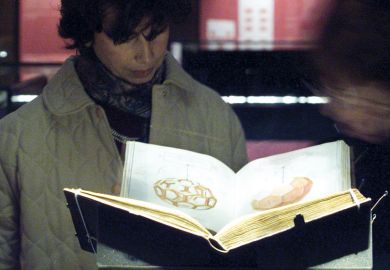This tale of the giant eyes on the sky that are revolutionising our knowledge of the universe reveals a fascinating piece of science policy and science history. But it is also relates the much more interesting drama of conflicting views about where knowledge comes from, what a university is and how research should be organised.
Postwar astronomy started big when the California Institute of Technology (Caltech) opened the 200in (5m) telescope on Mount Palomar in 1948. But this remained the world's largest telescope until the Soviet Union inaugurated the 6m Bolshoi in 1976. Only in 1993 did the 10m Keck 1 telescope on Hawaii put a bigger machine in the hands of US astronomers.
Now there is a series of big telescopes with mirrors up to 10m across, or combining light from several mirrors in the 8m range, and there are plans for telescopes several times this size.
The exuberance of ground-based optical astronomy is due partly to the emergence of new funders such as the European Southern Observatory and the Japanese Government, which have built large telescopes in Hawaii and Chile.
There is also new technology. The new telescopes rely on the ability to create very large thin mirrors or to combine light from several small ones.
They also use adaptive optics, which the US Air Force developed to study Soviet satellites, to remove the twinkle from starlight and allow ground-based telescopes to compete with those in orbit. The USAF had for years an observatory on Hawaii with better optics than anything available to civilian scientists, and spy satellites pointed at the Earth instruments far more powerful than any astronomers could use to peer into space.
The one rule that has been followed throughout, says Patrick McCray, is that nobody is allowed a bigger telescope than Caltech. But the real divide has been between Caltech (and a few other universities with adequate telescope power) and most others, which had to rely on the resources of the government's National Optical Astronomy Observatories, which has been beset by chronic political, technical and organisational crises.
McCray makes useful comparisons with non-US experience, including the saga of UK telescopes in Spain, Australia and Hawaii, but in general his book is too US-centric. For example, he refers to Hubble, a US-European joint venture, as a US "national" telescope.
The growing scale of the astronomical enterprise has also changed what it is to be an astronomer. Many professionals resent the fact that observation no longer consists of a scientist and a telescope alone on a mountain top, fighting to extract information from an uncompromising sky. Now roomfuls of technicians are on hand. The scientist may be thousands of miles away and may send a request for data to a remote centre and wait for the results to appear.
The big players call this progress. But there is a well-researched belief that a few big telescopes do not produce more or better science than many smaller ones. They certainly limit the number of people who can be trained as astronomers. Indeed, says McCray, a poll of US university astronomers would probably have rejected some of the recent big telescopes as a priority in favour of buying every astronomy department a 1m telescope. The result would have been more happiness for astronomers, and perhaps more science.
Martin Ince is contributing editor, The Times Higher.
Giant Telescopes: Astronomical Ambition and the Promise of Technology
Author - W. Patrick McCray
Publisher - Harvard University Press
Pages - 367
Price - £29.95
ISBN - 0 674 01147 3



